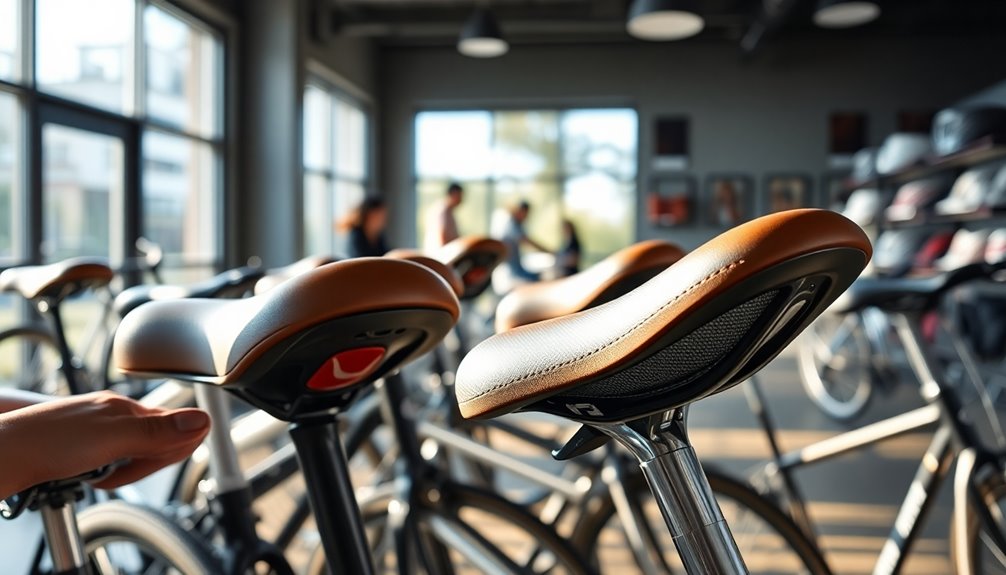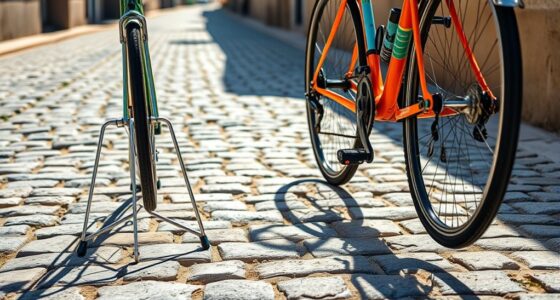Choosing the perfect bike seat is essential for your comfort and safety. Start by considering the type of riding you do, whether recreational or mountain biking. Think about the cushioning level that suits you and if a center cutout might relieve pressure. Material matters too; explore synthetic or leather options. Proper size and saddle shape can greatly enhance your experience. For more tips on improving your comfort and understanding saddle design, continue exploring your options.
Key Takeaways
- Select a saddle shape that matches your riding style, such as wide for recreational or narrow for road cycling, to enhance comfort and performance.
- Consider cushioning preferences; gel offers plush comfort for leisure rides, while foam provides firmer support for longer distances.
- Look for saddles with cut-out designs to relieve pressure on sensitive areas and improve ventilation during extended rides.
- Ensure proper saddle height and alignment with pedals to maintain comfort and reduce the risk of injury while cycling.
- Invest in padded bike shorts to minimize chafing and enhance overall riding comfort, especially during long-distance rides.
Consider the Type of Riding You Do

When you think about choosing a bike seat, consider the type of riding you do, as it can greatly impact your comfort and performance.
Choosing the right bike seat is crucial; it enhances both comfort and performance based on your riding style.
If you're a recreational cyclist, a wide saddle with plush padding suits your upright position, ensuring comfort during long rides.
Mountain bikers need a saddle designed with durable covers and targeted padding for sit bones, accommodating various riding styles and terrain challenges.
For bike touring, opt for a long, narrow saddle that provides cushioning for extended periods in the saddle—this helps with pressure relief.
Commuters should look for saddles akin to road or touring designs, featuring moderate padding and weather resistance, making your daily rides more enjoyable and comfortable.
Decide What Type of Cushioning You Want

How do you prioritize comfort and performance when choosing a bike seat?
If comfort's your main goal, consider cushioning saddles, which offer plush padding and springs to absorb bumps.
For a more tailored feel, gel cushioning molds to your body shape, making it popular among recreational cyclists.
If you're looking for something firmer, foam cushioning springs back into shape and often suits road riders aiming for longer distances.
On the other hand, if you're a competitive cyclist, performance saddles with minimal cushioning are designed for maximum power transfer and reduced chafing.
Ultimately, decide what type of cushioning aligns with your riding style to guarantee your bike seat enhances your overall experience.
Consider Whether You Want a Center Cutout
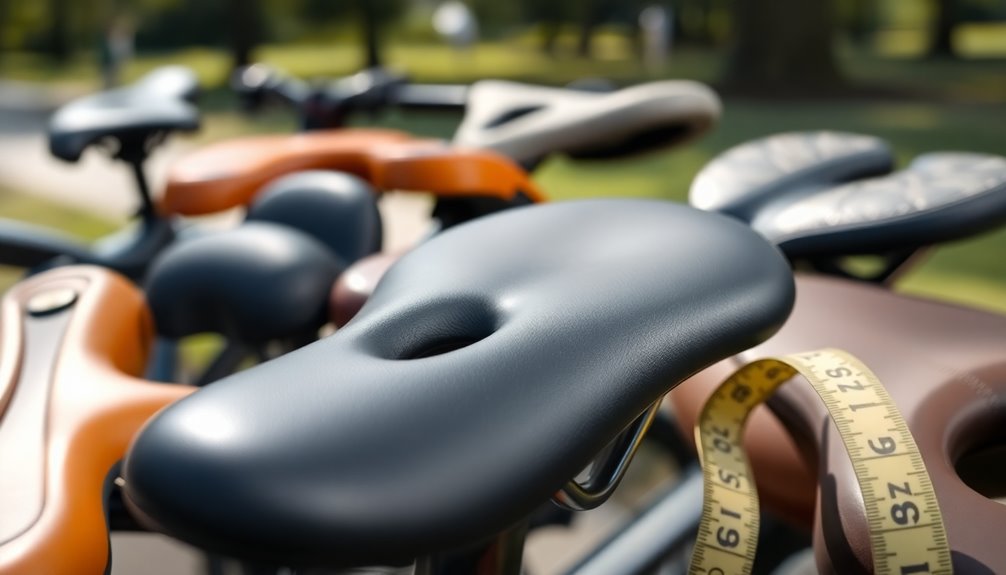
Have you considered the benefits of a center cutout in your bike seat? A center cutout is designed to relieve pressure on the perineal area, enhancing saddle comfort during long rides and reducing numbness. This feature can greatly improve your experience, especially if you're prone to discomfort.
Additionally, the cutout allows for better ventilation, which can be a game-changer if you often deal with heat buildup in sensitive areas. However, preferences vary; some riders swear by cutouts, while others prefer a traditional saddle for more versatility in movement.
Gender-specific designs also take anatomical differences into account, offering tailored relief. It's wise to test both styles to find the best fit for your personal anatomy and riding style.
Decide Which Saddle Materials You Prefer

Finding the right bike seat involves more than just the shape; the materials used can greatly impact your comfort and riding experience.
When choosing saddle materials, consider how they affect your rides:
- Synthetic saddle covers: Lightweight, low maintenance, and durable.
- Leather saddle covers: Molds to your shape over time for a custom fit, but may be uncomfortable initially and aren't waterproof.
- Cotton covers: Offer quicker comfort with some stretch, making them a great choice for those who want a faster break-in period.
Also, remember that saddle rails—made from steel, aluminum, or carbon—play a role in overall comfort and durability.
Each material has its pros and cons, so weigh your options carefully!
Get the Right Bike Saddle Size

Choosing the right bike saddle size is essential for your comfort and performance on the road.
To determine your ideal saddle width, measure your sit bones—this typically ranges from 3 to 5 inches. Adding about 2 cm to this measurement helps you find the appropriate saddle width.
Men usually prefer a width of 145 mm, while women often go for 155 mm, accommodating differences in hip width and sit bone location.
For peak support, a professional fitting is recommended, ensuring the saddle fits your ischial tuberosities perfectly.
Many bike saddle manufacturers provide measuring tools to assist you in selecting the right size.
Remember to test different saddle sizes to align with your comfort preferences and body type for the best fit.
Make Sure Your Saddle Is Properly Adjusted
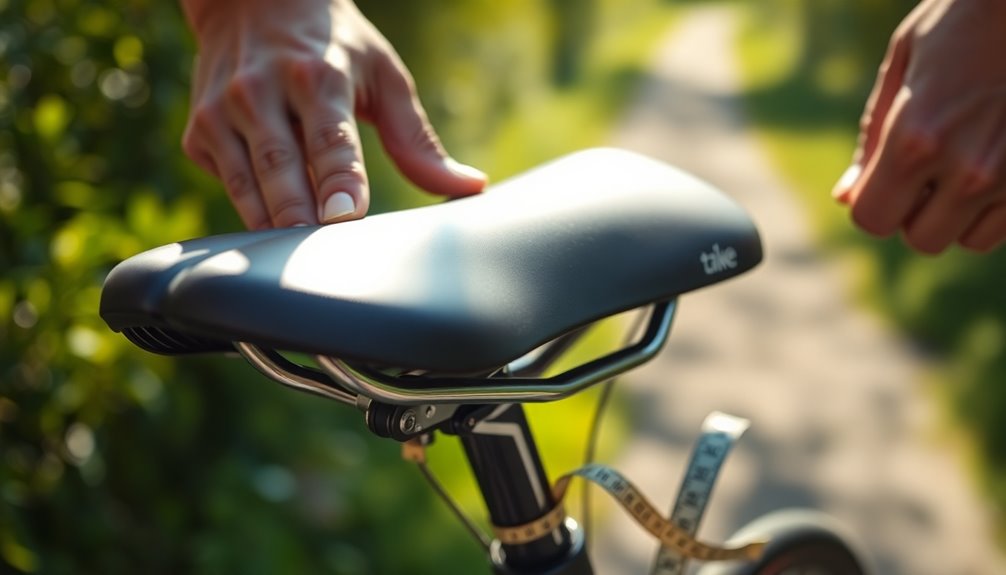
To get the most out of your rides, you need to adjust your saddle correctly.
Start by setting the height so there's a slight bend in your leg at the bottom of the pedal stroke, and make sure your knee aligns with the pedal axle when at the 3 o'clock position.
Finally, keep your saddle level or slightly nose-down for best comfort while riding.
Saddle Height Importance
Ensuring your saddle height is properly adjusted is essential for both comfort and performance while riding. A well-fitted saddle height allows for a slight bend in your leg at the bottom of the pedal stroke, promoting efficient pedaling and reducing irritation.
Here are key points to reflect on:
- Maintaining knee alignment over your forefoot at the 3 o'clock position enhances comfort and performance.
- A saddle that's too high can cause hip movement and discomfort, while one that's too low may strain your knees.
- Regularly adjusting your saddle as your fitness levels change or when switching riding styles can greatly improve your overall comfort.
Investing time in adjusting your saddle height can make a world of difference in your riding experience.
Fore/Aft Position Alignment
Getting the fore/aft position of your saddle right is vital for maximizing comfort and efficiency on your bike. The ideal alignment places your knee directly over the pedal axle when your pedal is at the 3 o'clock position. This setup guarantees peak power transfer while reducing the risk of knee strain.
A properly adjusted saddle helps distribute your weight evenly, preventing excessive forward or backward shifts that can lead to discomfort or chafing during longer rides. Additionally, the correct fore/aft position allows your pelvis to rotate naturally, minimizing pressure on sensitive areas and avoiding saddle sores.
Remember to reassess your saddle's alignment regularly, especially after changes in riding style or body weight, to maintain that vital comfort.
Level Saddle Angle
A properly adjusted saddle angle is essential for a comfortable ride. Setting your saddle level or slightly nose-down helps prevent excessive pressure on sensitive areas. An incorrect angle can lead to discomfort, pain, and chafing, so make sure your saddle stays parallel to the ground.
Here are key points to take into account when adjusting your saddle angle:
- Align the nose with the rear of the saddle for ideal weight distribution.
- Regularly reassess your saddle angle as your riding style changes.
- A well-adjusted saddle enhances your riding position and overall comfort.
Tips to Improve Your Comfort in the Saddle
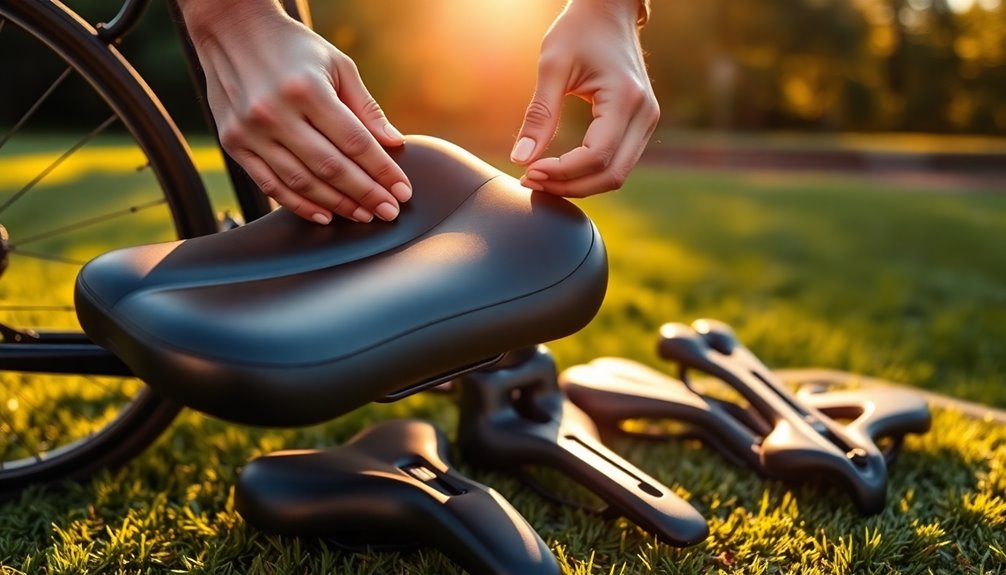
To boost your comfort in the saddle, start by ensuring your saddle height is just right for you.
Wearing padded bike shorts can make a big difference too, reducing friction on longer rides.
Don't forget to stand on the pedals every now and then to relieve pressure and keep the blood flowing.
Adjust Saddle Height Properly
Adjusting your saddle height properly is essential for both comfort and safety while riding. The right saddle height guarantees your leg has a slight bend at the bottom of the pedal stroke, maximizing your pedaling efficiency and reducing strain.
Here are some tips to take into account:
- Maintain proper knee alignment over the pedal axle to prevent injuries.
- Keep the saddle parallel to the ground; any tilt can lead to discomfort.
- Use quick-adjust seatposts for easy modifications, especially during frequent riding on varying terrains.
Regularly reassess your saddle height, particularly after changes in riding style or body weight, to maintain ideal performance.
With these adjustments, you'll enjoy a more comfortable and safer ride.
Use Padded Bike Shorts
Choosing the right padded bike shorts can transform your riding experience, making long journeys far more enjoyable.
These shorts greatly reduce friction between the saddle and your skin, minimizing the risk of chafing. The chamois built into padded bike shorts wicks moisture away, keeping you dry and comfortable on longer rides.
Plus, they provide extra cushioning for your sit bones, enhancing comfort, especially on rough terrain. Properly fitted padded bike shorts also help maintain your riding posture by keeping you securely in place on the saddle, which can improve your performance and reduce discomfort.
Investing in high-quality padded bike shorts can make a noticeable difference, particularly if you regularly engage in long-distance cycling or recreational riding.
Stand on Pedals Regularly
While riding, standing on the pedals regularly can greatly enhance your comfort and performance. Every 10 minutes, this simple technique can relieve pressure on your sit bones, promoting better circulation.
It also engages your leg muscles, acting as natural shock absorbers over bumps and rough terrain, which is especially beneficial during mountain biking.
Here are a few tips to keep in mind:
- Practice standing techniques during training rides to build comfort and confidence.
- Incorporate brief standing intervals to improve balance and control on uneven surfaces.
- Alternate between sitting and standing to prevent discomfort and fatigue.
Additionally, emotional regulation can be improved through physical activities like biking, as it helps manage stress and boosts overall well-being.
Understanding Saddle Shape and Design
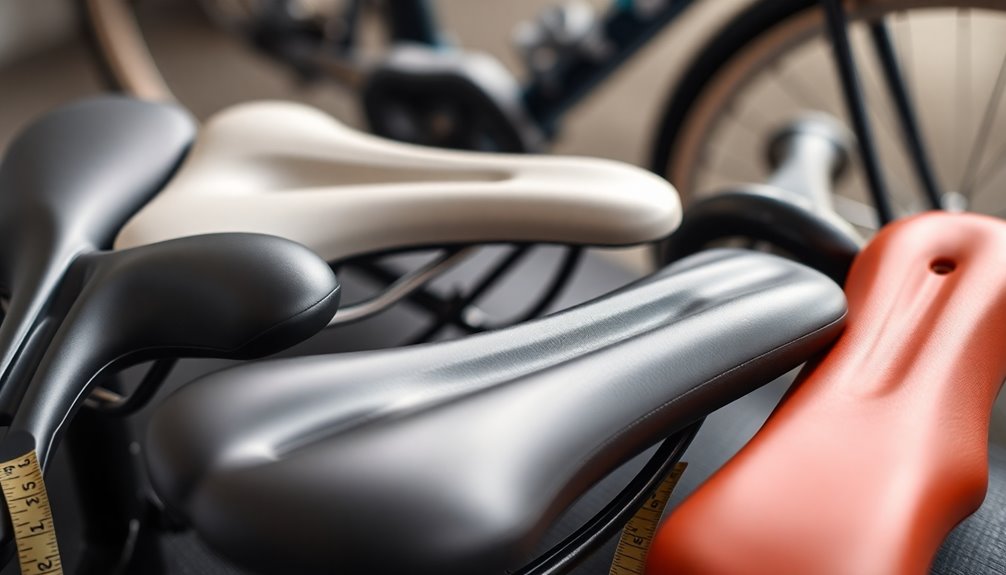
When it comes to bike comfort, understanding saddle shape and design is vital for an enjoyable ride. The saddle shape affects how your body interacts with the bike, influencing both comfort and pressure distribution.
For instance, road bike saddles are typically long and narrow, while mountain bike saddles are wider and flatter to accommodate various riding positions. Curvature and design play significant roles in maintaining body centering and reducing chafing.
Additionally, the length of the saddle nose affects weight distribution, especially during climbs. Cut-out designs can relieve pressure on sensitive areas, making them ideal if you experience numbness on long rides.
Choosing the right saddle shape guarantees that your cycling experience is both comfortable and efficient.
Evaluating Saddle Padding Levels

Evaluating saddle padding levels is essential for achieving ideal comfort during your rides. You'll want to balance cushioning with performance. Performance saddles typically have minimal padding for better power transfer, while comfort saddles may feature extra foam or gel padding.
Consider these factors when choosing saddle padding:
- Personal comfort levels: Everyone's needs vary, so test different options.
- Padding type: Foam padding offers different densities, while gel padding conforms to your body.
- Weight considerations: Extra padding can gain weight, affecting performance.
Finding the right saddle padding can enhance your riding experience, ensuring you stay comfortable without sacrificing performance. Additionally, prioritizing emotional resilience can help you cope with any discomfort during long rides.
Always remember to prioritize proper blood flow to avoid circulation issues on long rides.
Innovations in Saddle Design
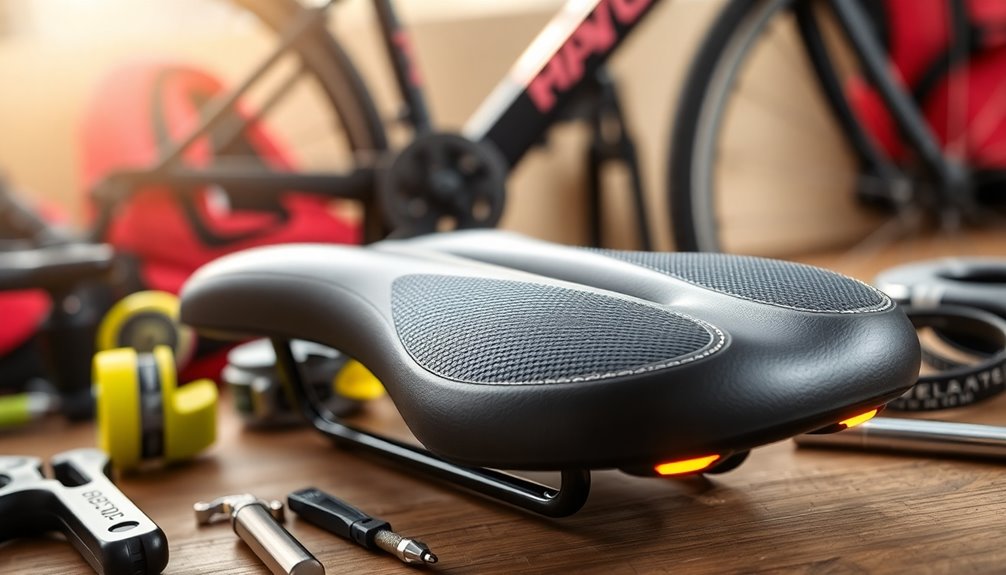
When it comes to saddle design, 3D printing technology is changing the game, offering you customized shapes and cushioning that fit your riding style perfectly.
This innovation means you can enjoy a bike seat tailored specifically to your preferences, enhancing both comfort and performance.
With these advancements, finding the right saddle has never been easier.
3D Printing Technology
As you explore the advancements in saddle design, you'll find that 3D printing technology is revolutionizing the way comfort and support are tailored to individual riders.
This innovative approach allows for precise customization, addressing various anatomical differences and rider preferences.
Key benefits of 3D printed saddles include:
- Enhanced pressure relief through optimized weight distribution
- Shorter break-in periods due to engineered materials for immediate comfort
- Hybrid designs, like the Specialized Power Expert, combining traditional materials with 3D printed padding
With these advancements, your riding experience can markedly improve, especially during long distances.
Investing in a 3D printed saddle means you're prioritizing comfort and safety, making every ride enjoyable and tailored just for you.
Customization Options Available
The advancements in saddle design have opened up a world of customization options that cater specifically to your needs as a rider. With innovations like 3D printing, you can now create a saddle that fits your unique anatomy and preferences.
High-end models, such as the Specialized Power Expert with Mirror, combine traditional covers with 3D-printed padding for unmatched comfort. You can select features like cut-out designs and padding density to relieve pressure points, enhancing your riding experience.
The trend towards shorter-nose saddles also offers better maneuverability while maintaining comfort, appealing to various riding styles. Plus, affordable options utilizing 3D printing technology are making personalized saddle choices accessible to everyone, ensuring you find the perfect fit for your rides.
Frequently Asked Questions
How Do I Find the Most Comfortable Bike Seat?
To find the most comfortable bike seat, start by measuring your sit bone width and look for a saddle that's about 2cm wider.
Consider your riding style, as different activities require different saddle shapes.
Pay attention to padding; too much can cause circulation issues on longer rides.
Evaluate cut-out designs for pressure relief, and don't hesitate to test multiple saddles.
Many brands offer guarantees, so you can exchange if it's not the right fit.
What Is the 0.883 Rule?
The 0.883 Rule is a guideline for selecting the right bike saddle width.
It suggests that your saddle should be about 88.3% of the distance between your sit bones.
To find your ideal saddle width, measure the distance between your sit bones and multiply that number by 0.883.
This approach helps guarantee you get a comfortable fit, reducing pressure points and enhancing your overall riding experience.
Is There Such a Thing as a Comfortable Bicycle Seat?
Yes, there's such a thing as a comfortable bicycle seat, but it really depends on your preferences and riding style.
You'll find that different shapes, widths, and padding materials can greatly affect your comfort.
It's crucial to test various options and consider factors like saddle cut-outs or cushioning.
What Is the Most Comfortable Position on a Bike?
The most comfortable position on a bike really depends on your riding style.
If you're cruising leisurely, an upright stance works best, while a forward-leaning position is ideal for road cycling.
Adjust your saddle height so there's a slight bend in your leg at the bottom of the pedal stroke.
Keep your knees aligned over your feet to distribute weight evenly and enhance comfort.
Experiment with saddle tilt to find what feels right for you.
Conclusion
Choosing the perfect bike seat isn't just about comfort; it's about connecting with your ride. When you find the right saddle, you might discover a newfound joy in cycling—an unexpected coincidence that transforms your experience. It's not just about the miles you cover, but how you feel along the way. So, take the time to explore your options and tailor your choice, and you'll ride not just further, but happier, too.
